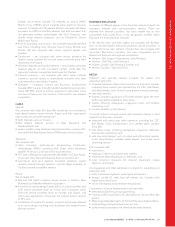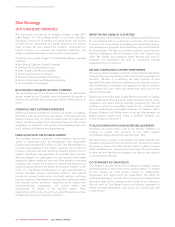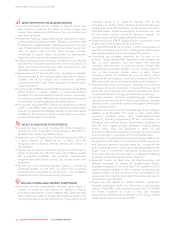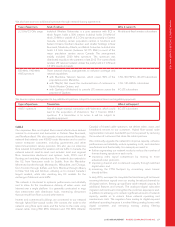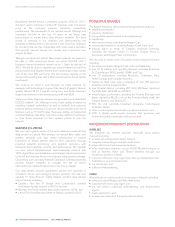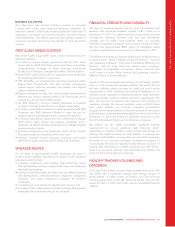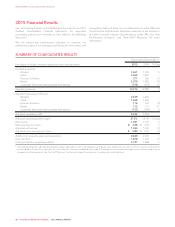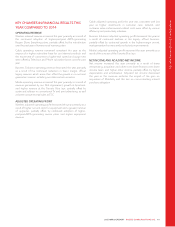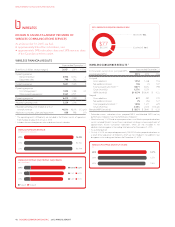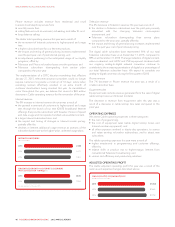Rogers 2015 Annual Report Download - page 39
Download and view the complete annual report
Please find page 39 of the 2015 Rogers annual report below. You can navigate through the pages in the report by either clicking on the pages listed below, or by using the keyword search tool below to find specific information within the annual report.
MANAGEMENT’S DISCUSSION AND ANALYSIS
We also have access to additional spectrum through network sharing agreements:
Type of spectrum Kind of venture Who it supports
2.3 GHz/3.5 GHz range Inukshuk Wireless Partnership is a joint operation with BCE in
which Rogers holds a 50% interest. Inukshuk holds 30 MHz (of
which 20 MHz is usable) of 2.3 GHz spectrum primarily in Eastern
Canada, including certain population centres in Southern and
Eastern Ontario, Southern Quebec, and smaller holdings in New
Brunswick, Manitoba, Alberta, and British Columbia. Inukshuk also
holds 3.5 GHz licences (between 50-175 MHz) in most of the
major population centres across Canada. The arrangement
initially included 2500 MHz spectrum. This spectrum was
distributed equally to the partners in late 2012. The current fixed
wireless LTE national network utilizes the jointly held 2.3 GHz and
3.5 GHz spectrum bands.
Mobile and fixed wireless subscribers.
850 MHz, 1900 MHz
AWS spectrum
Three network-sharing arrangements to enhance coverage and
network capabilities:
• with Manitoba Telecom Services, which covers 96% of the
population across Manitoba;
3.5G /4G HSPA+, 4G LTE subscribers.
• with TBayTel, that covers the combined base of customers in
North Western Ontario; and
3.5G / 4G HSPA+ subscribers.
• with Quebecor (Videotron) to provide LTE services across the
province of Quebec.
4G LTE subscribers.
We have an option arrangement to buy additional spectrum, subject to commercial terms and regulatory approvals:
Type of spectrum Transaction Who it will support
AWS-1 spectrum Part of a larger strategic transaction with Videotron, which could
lead to the acquisition of Videotron’s Tier 3 Toronto AWS-1
spectrum. If a transaction is to occur, it will be subject to
regulatory approval.
4G LTE subscribers.
CABLE
Our expansive fibre and hybrid fibre-coaxial infrastructure delivers
services to consumers and businesses in Ontario, New Brunswick,
and Newfoundland. We also operate a transcontinental fibre-optic
network that extends over 48,000 route kilometres and is used to
service enterprise customers, including government and other
telecommunications service providers. We also use our extensive
fibre network for backhaul for wireless cell site traffic. In Canada, the
network extends coast-to-coast and includes local and regional
fibre, transmission electronics and systems, hubs, POPs, and IP
Routing and switching infrastructure. The network also extends to
the US, from Vancouver south to Seattle, from the Manitoba-
Minnesota border through Minneapolis, Milwaukee, and Chicago,
from Toronto through Buffalo, and from Montreal through Albany
to New York City and Ashburn, allowing us to connect Canada’s
largest markets, while also reaching key US markets for the
exchange of data and voice traffic.
The network is structured to optimize performance and reliability
and to allow for the simultaneous delivery of video, voice, and
Internet over a single platform. It is generally constructed in rings
that interconnect with distribution hubs, minimizing disruptions
that can result from fibre cuts and other events.
Homes and commercial buildings are connected to our network
through hybrid fibre-coaxial nodes. We connect the node to the
network using fibre optic cable and the home to the node using
coaxial cable. Using 860 MHz (Ontario) and 750 MHz (Atlantic
Canada) of shared cable spectrum, we deliver video, voice, and
broadband services to our customers. Hybrid fibre-coaxial node
segmentation increases bandwidth per home passed by reducing
the number of customers that share the cable spectrum.
We continually upgrade the network to improve capacity, enhance
performance and reliability, reduce operating costs, and introduce
new features and functionality. For example, we invest in:
• further segmenting our network nodes to reduce the number of
homes sharing spectrum in each node;
• improving video signal compression by moving to more
advanced video protocols;
• improving channel and on-demand capacity through switched
digital video; and
• increasing the FTTH footprint by connecting more homes
directly to fibre.
In early 2016, we expect to complete the transitioning of customers
receiving television signals over our analog broadcast channels to
all-digital services, freeing up significant cable network capacity for
additional features and services. The analog-to-digital subscriber
migration will continue to strengthen the customer experience and,
in addition to allowing us to reclaim significant amounts of network
capacity, enable us to reduce future network operating and
maintenance costs. The migration from analog to digital required
additional spending because it involved fitting analog homes with
digital converters and removing existing analog filtering
equipment.
2015 ANNUAL REPORT ROGERS COMMUNICATIONS INC. 37


